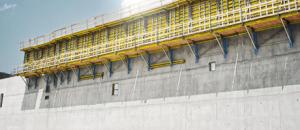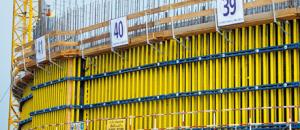Press Contact
Impressions
Anchored by a single delta-shaped concrete pylon, the top of the new bridge will be 316 feet above the River in a fanned, cable-stay assembly. Also called the Christopher S. Bond Missouri River Bridge, it will be distinguished by its height. The bridge will include three through lanes in each direction, and a merge lane for northbound traffic to enter and exit the bridge. It will also have a southbound bicycle and pedestrian crossing that will be separated from roadway traffic by a barrier. The roadway deck is divided in half by a concrete median with two-foot concrete guard rails on the sides to provide drivers with a clear view from the bridge.
The aesthetic design has indentations in each edge of the pylon, therefore reducing its visual bulk and the amount of concrete required to cast the structure. The legs of the pylon are compact and were designed to appear as if they dissolve into the river bed. The designer, Bradley Touchstone with DodStone Group, had a distinct architectural view in mind for this bridge. As a result, the contractor, Paseo Corridor Constructors, who was hired by the Missouri Department of Transportation (MoDOT), needed a formwork solution to meet the challenges of constructing the new Paseo Bridge.
Doka was selected to provide the engineering solutions and formwork for the top half of the bridge pylon, one of the most important features of the bridge. Also, having worked with the contractor in 2002 on a similar H-style pylon bridge, Doka was already familiar with the requirements for creating pylons, which made them a fit for the project. It was essential that the formwork solution facilitate the 20-foot concrete pours using self-climbing formwork. Doka provided 10 SKE100; 2,200 square feet of Top 50; 1,000 square feet of custom steel forms; 12 MF240 support brackets and eight D22 support brackets. Two sets of formwork were provided, one for each pylon. Doka incorporated all of the formwork systems to provide customization to meet the contractor’s unique needs.
Top 50 was used on the outside face of the bridge pylon, which is inclined at a 20 degree slope with four outside faces. This forming equipment is designed to provide easy and efficient forming sequences for large-area projects. The Top 50 system can be configured for fast and safe stripping of the formwork, after which the interior forms can be immediately reconfigured and rapidly re-set into the next casting.
MF240 support brackets created an 8-foot working surface and were used on each side of the pylon along with Top 50. MF240 is a crane-lifted climbing formwork for structures of any shape and any angle of inclination. Key to regular work cycles on all high structures, this formwork system can be adapted to a very wide range of field requirements. The dam formwork, D22, was used on the short angle faces to provide a quality crane-handled formwork system. It was chosen due to its extraordinary load capacity and ability to facilitate tall pours. The pours were 5 feet by 8 feet and were 20 feet tall, which is top-heavy for 70 degree inclined pylon. D22 was able to resist this load as it is designed for block heights up to 13 feet and tensile forces of the anchor of up to 220 kN with a working platform of 7.8 feet in width. On the sloping side of the bridge pylon, SKE100 in conjunction with Top 50 was used to support the vertical dead weight of the concrete. Doka’s automatic climbing formwork, SKE100, is used for high formwork scaffolds and heavy loads, allowing workers to separate forming and reinforcement work. It has a load-carrying capacity of 10 metric tons per bracket, allows for simultaneous work at different levels and is extremely strong.
"The use of SKE100 in conjunction with Top50 enabled us to cycle much faster than we ever anticipated,” said Dale Helmig, Project Manager for Paseo Corridor Constructors. “We found it was exceptionally strong and it effortlessly supported the vertical weight."
Doka’s work on the diamond-shaped pylon began April 2009 and is scheduled for completion in summer 2010. One of the major challenges to date was the need to provide custom forms on the inside of the pylon with enough stripping so the contractor could have access for workers. Doka met this challenge by providing a custom collapsible steel core and platform on the interior to facilitate the cycle. Doka also recommended the use of guide rollers on the formwork so that the team could roll the formwork up the interior of the shaft after each pour.
An additional challenge for the team was the extreme angle of the bridge. Due to this angle and the extreme pressure of concrete, they needed significant support to form the pylon. Doka solved this unique challenge by providing a custom formwork solution incorporating various systems that would meet the needs of the owner and contractor. This custom system also allowed workers to quickly strip and move pieces with minimal use of a crane.
“The owner and contractor were very satisfied with Doka’s excellent engineering advice and commitment to service,” noted Dave Monnot, Major Account Manager.
The project began April 2008 and is scheduled for completion this summer. The total cost of the contract is $245 million and the result is a long-lasting iconic bridge over the Missouri River.
This could also be of interest for you:
Do you have any questions on the article? Get in touch with us!






